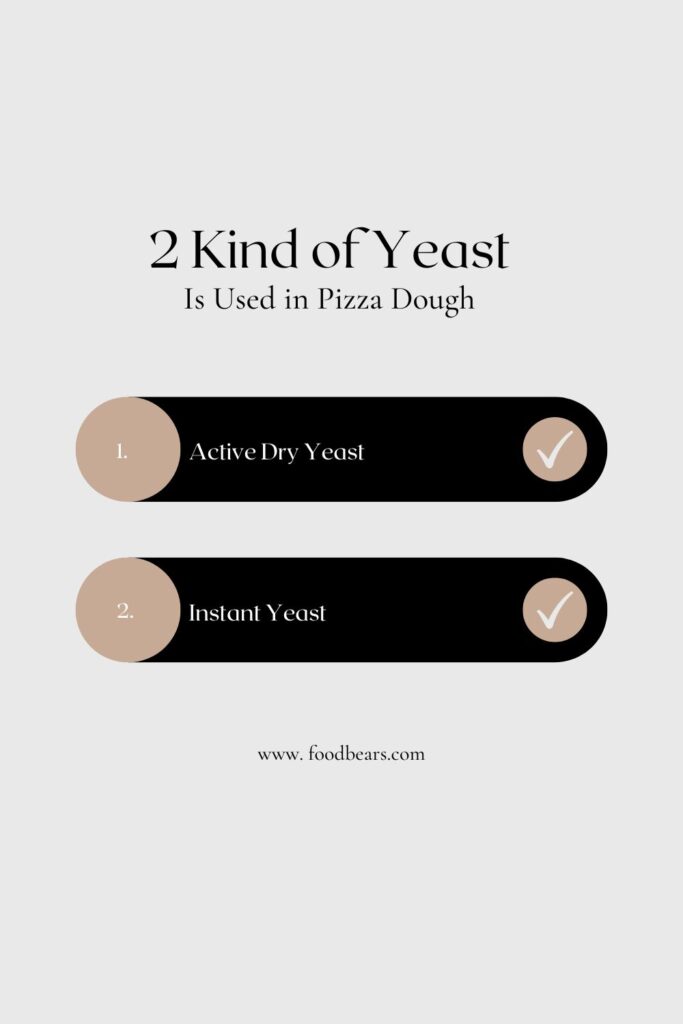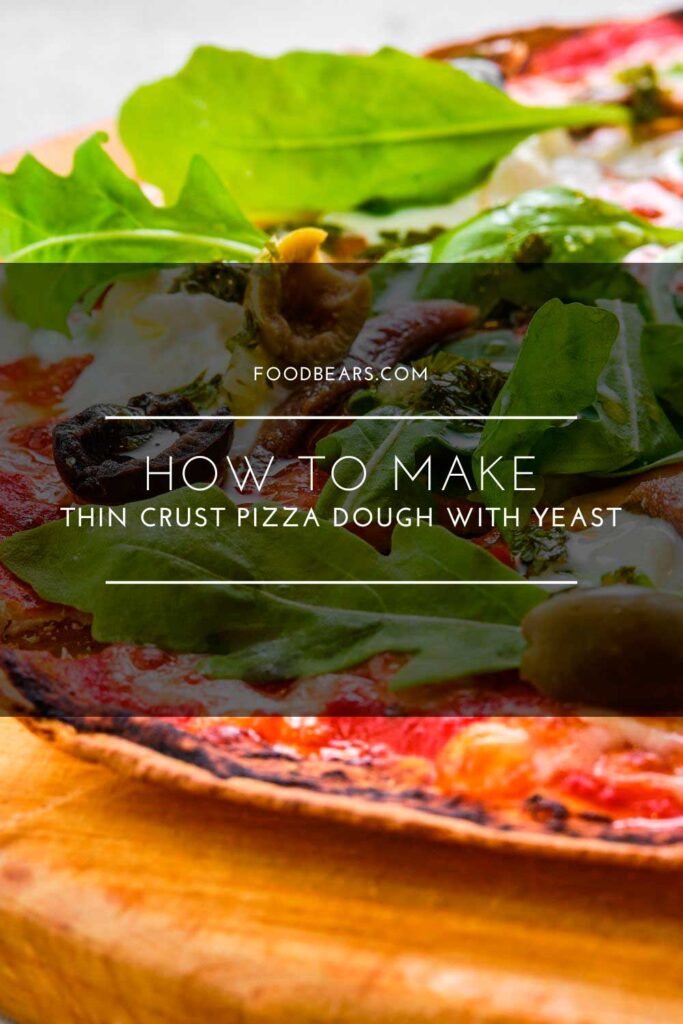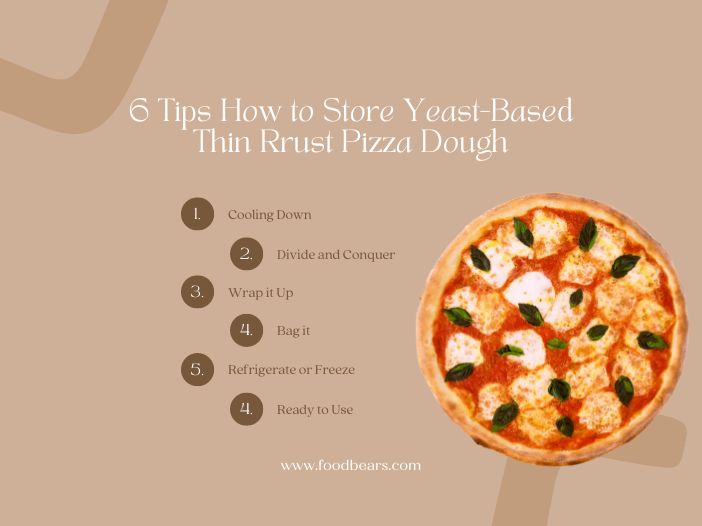Yes, thin crust pizza often contains yeast. However, it's not as simple as it seems. There's a common misconception that thin crust pizza is always yeast-free. But that's not entirely true.
As a pizza lover, I’ve often pondered the science behind my favorite dish. The crust, in particular, has always intrigued me.
Is it the yeast that gives it that perfect crunch? Or is it something else entirely? The answer isn’t as straightforward as you might think.
The role of yeast in pizza dough, the difference between thin crust and other types. And the impact of yeast-free recipes is all fascinating aspects of pizza making that often go unnoticed. But don’t worry. I’m here to delve into these mysteries with you.
So, grab a slice of your favorite pizza, and let’s embark on this delicious journey together!
Does Thin Crust Pizza Dough Require Yeast?

Yes, traditional thin-crust pizza dough requires yeast. Yeast is a key ingredient in most pizza dough recipes, including thin crust, because it makes the dough rise and gives it its unique texture and flavor.
Yeast is a fungus that ferments the sugars in the dough, producing carbon dioxide gas and alcohol.
The carbon dioxide gas gets trapped in the dough, causing it to rise and create the airy texture we saw with the pizza crust.
Even in thin-crust pizza, a small amount of yeast is typically used to achieve a light, crispy texture.
However, it’s important to note that variations of thin-crust pizza dough do not use yeast. These are often quicker to prepare, resulting in a denser, cracker-like crust.
The choice to use yeast or not depends on personal preference and the specific style of pizza you’re aiming to create.
What Kind of Yeast Is Used in Pizza Dough to Make Thick Crusts?

The type of yeast you use can make a real difference in your pizza dough. When it comes to yeast for pizza dough, we’re mainly talking about two types:
1. Active Dry Yeast
This is the everyday hero you’ll find hanging out in most grocery stores. Active dry yeast is made up of tiny, partially dehydrated granules. Here’s the catch – this yeast needs a little wake-up call before it gets to work.
You need to mix it with warm water to kickstart the rising process. All systems go once it’s awake and ready, and you’ll need to give your dough some proofing time.
2. Instant Yeast
Say hello to the speedster of the yeast world. Also known as fast-acting or quick-rise yeast, this type has been dried out quickly and comes in much finer granules than its active dry cousin.
The magic of instant yeast? It gets to work right away. Mix it directly into your dry ingredients, and your dough rises immediately. This can be a real game-changer if you’re strapped for time.
3. What to Use?
Now, when we’re talking about making pizza with thin crust, traditionally, active dry yeast has been the go-to. But traditions are made to be broken, right? Don’t be afraid to try out instant yeast. It might just surprise you with its efficiency and the results it delivers.
But it’s not all about the yeast. Making a superb thin-crust pizza is also about the kneading, the rolling, and, most importantly, the love you put into it.
| Type of Yeast | Description | When to Use |
|---|---|---|
| Active Dry Yeast | Common, granular, needs to be activated with water, requires proofing time | The traditional choice for thin crust pizza, when you have more time on your hands |
| Instant Yeast | Dries quickly, finer granules, starts rising dough immediately, mixed directly into dry ingredients. | It is a great alternative when you’re in a hurry, but it still delivers excellent results. |
How to Make Thin Crust Pizza Dough with Yeast?

The thin-crust pizza recipe is more straightforward than you might think. You’ll feel the satisfaction when you pull out your homemade thin-crust pizza from the oven. Let’s do it.
The Ingredients
Our adventure starts at the grocery store. For basic thin-crust pizza dough, you’ll need the following:
- 1 teaspoon of active dry yeast (remember our friend from the yeast aisle? That’s the one!)
- 3/4 cup of warm water
- 2 cups of all-purpose flour
- 1 teaspoon of salt
- 1 tablespoon of olive oil
The Journey
- Step 1 – Waking up the Yeast: First, you must wake up your yeast. In a large bowl, dissolve the yeast in warm water. Let it sit for about 5 minutes until it’s frothy and bubbling – that’s when you know your yeast is ready to work its magic.
- Step 2 – Mixing the Dough: Now, add the flour, salt, and olive oil to the yeast mixture. Stir until it comes together. It should form a slightly sticky ball. If it’s too dry, add a bit more water. If it’s too wet, add a bit more flour.
- Step 3 – Kneading the Dough: Lightly flour your hands and work surface, and start kneading. Push, fold, turn, push, fold, turn. Rolling the dough for about 5 minutes until it’s smooth and elastic.
- Step 4 – Resting Time: Now, let your dough rest. Cover the bowl with a clean kitchen towel and let it sit for about an hour. It won’t rise much – that’s okay. Because it’s thin-crust pizza.
- Step 5 – Shaping the Pizza: Preheat your oven to its highest setting, usually around 500°F (260°C). Now comes the fun part – shaping your pizza. Roll out your dough as thin as you like. Remember, it’s your pizza, so you’re the boss here!
- Step 6 – Topping and Baking: Add your favorite toppings. Not too much, or your thin crust might get soggy. Don’t overpower the pizza sauce. Pop your pizza in the preheated oven and bake for 10-15 minutes, until the crust is crispy and the cheese is bubbly and golden.
And voilà! You’ve just made your very own thin-crust pizza dough with yeast.
How to Make Thin Crust Pizza Dough without Yeast?
Making a thin-crust pizza dough without yeast is not only doable but surprisingly simple. And the result? A crispy, flavorful base ready to take on your favorite toppings. So, roll up your sleeves, and let’s explore the pizza dough recipe.
The Ingredients
Our shopping list is short and sweet. For a basic yeast-free thin-crust pizza dough, you’ll need the following:
- 2 1/2 cups of all-purpose flour
- 3 teaspoons of baking powder
- 1 teaspoon of salt
- 1 tablespoon of olive oil
- 3/4 to 1 cup of water
The Journey
- Step 1 – Mix Dry Ingredients: Begin by whisking your flour, baking powder, and salt in a large bowl. These are the backbone of your pizza dough.
- Step 2 – Add Wet Ingredients: Pour in the olive oil, followed by 3/4 cup of water. Use a spoon to stir the mixture. Add the remaining water a little at a time if it feels dry. Ensure to make the dough soft but not sticky.
- Step 3 – Knead the Dough: Keep the dough on a floured surface, countertop, or work surface. Turn your dough onto this surface and knead it for 3-4 minutes. You have to form a smooth, elastic dough.
- Step 4 – Roll Out the Dough: No need to wait for the dough to rise (that’s the beauty of a yeast-free recipe!). Roll the dough out into your desired pizza shape. If you like a super thin dough, just go for it. Want a little more bite? Leave it a bit thicker.
- Step 5 – Top and Bake: Now comes the fun part. Top your pizza with your favorite ingredients, but remember, less is more with a thin crust. Overloading it can make your pizza soggy. Bake in a preheated oven (about 450°F or 232°C) for 12-15 minutes or until the crust is golden and the cheese is bubbly and slightly browned.
And there you have it – a beautiful, homemade, thin-crust pizza without a trace of yeast.
How to Store Yeast-Based Thin Rrust Pizza Dough?

What happens when you’ve made a bit more dough than your pizza-loving heart can handle? You can store your yeast-based thin-crust pizza dough for future pizza cravings.
Generally, you can store homemade pizza dough for up to 5 days in a fridge and up to 3 months in a freezer. Here’s a step-by-step guide on how to do it:
1. Cooling Down
After you’ve mixed and kneaded your dough, it’s likely to warm from the process and the chemical reactions. It can continue fermenting and potentially spoil if stored in this state.
So, give it time to cool down and rest at room temperature. This also relaxes the gluten, making your dough easier to handle later.
2. Divide and Conquer
You know how much dough you typically use for a pizza. So, why not make it easier on your future self? Take your large dough and divide it into portions that would each make one pizza. This can save you the hassle of breaking off just the right amount from a large, cold dough later.
3. Wrap it Up
Air is the enemy of your pizza dough. If exposed, it can dry out and form a hard crust that’s unpleasant to eat. To prevent this, wrap each dough ball tightly with plastic wrap. It’s like a protective jacket for your dough, keeping it safe from the cruel, dry world outside.
4. Bag it
Put your wrapped dough balls into a zip-top bag for an added protection layer. This is a second barrier against any air that might have sneaked in. Try squeezing as much air from the bag as possible before sealing it.
5. Refrigerate or Freeze
Depending on when you plan to use the dough, you can refrigerate or freeze it. The refrigerator is a safe bet if you will use it within the next 1-3 days. But if you’re storing for longer, say a week or more, you should opt for the freezer.
In there, your dough will stay in suspended animation, waiting patiently for its time to shine.
6. Ready to Use
You’ve stored your dough, and it’s time to use it. If it is in the refrigerator, just give it time to come to room temperature before you start working with it. If you freeze your dough, move it to the refrigerator the day before using it.
This lets it thaw slowly and evenly. Once it’s thawed, treat it like dough you’ve refrigerated, letting it come to room temperature before rolling.
How Does Yeast Affect the Texture of Thin Crust Pizza?
Yeast is small, but it helps make your thin-crust pizza delicious. It’s all about the balance – the delicate dance between crunch and chew, strength and tenderness. And that dance is choreographed by yeast.
- The Rising Action: Yeast feeds on the sugars in your dough, and as it does so, it releases carbon dioxide gas. This gas gets trapped in the dough, forming tiny bubbles that cause it to rise. This step is still crucial even though I am talking about thin-crust pizza. Without yeast, your pizza would be more like a cracker than a crust.
- The Crumb Structure: Have you ever bitten into a pizza and noticed the soft, airy interior of the crust? That’s all thanks to yeast. The bubbles it creates give your crust its unique structure known as the crumb. A good crumb is a beautiful balance of airiness and chewiness; yeast is the key to achieving it.
- Texture Matters: Yeast helps your pizza strike that perfect balance between crispy on the outside and soft on the inside. It creates a firm crust to hold your toppings yet is tender enough to enjoy with every bite. Without yeast, you might end up with a hard and brittle crust.
- Flavor Profile: It’s not all about texture, though. Yeast also adds to the flavor of your pizza crust. As it feeds on the sugars, it produces carbon dioxide and alcohol. This alcohol evaporates during baking, leaving behind a subtle, complex flavor. It’s a small thing, but it can make a difference in your pizza.
Does All Pizza Contain Yeast?
No, not all pizza contains yeast.
Pizza dough is typically made with yeast, a fungus that helps the dough rise by producing carbon dioxide gas during fermentation. This results in a light, airy crust characteristic of many types of pizza, especially those in the Neapolitan and New York styles.
However, many types of pizza do not require yeast. For example, thin-crust pizzas such as the Italian “Pizza Romana” or the “Pizza alla Napoletana” often use a yeast-less dough.
Similarly, some homemade pizza recipes might use baking powder or baking soda as leavening agents instead of yeast. Especially for quick dough recipes that don’t have time to rise.
In addition, many flatbread pizzas do not use any leavening agents at all. It makes a fragile and crispy crust. An example is the traditional Italian “Schiacciata,” often topped with olive oil, salt, and various toppings.
So, while yeast is common in many pizza dough recipes, it is not a necessary ingredient for all types of pizza.
FAQs
Is Italian pizza made with yeast?
Absolutely! Traditional Italian pizza dough is made with yeast. The yeast helps the dough to rise, giving it a light, airy texture. It’s a crucial component of the classic Neapolitan pizza originating in Naples, Italy.
What percentage of yeast is in pizza?
Typically, for a basic pizza dough recipe, you might use about 1 to 2% yeast compared to the weight of the flour. For instance, if you’re using 500 grams of flour, you might use 5 to 10 grams of yeast. However, the exact amount can vary based on the specific recipe and the desired rise time.
Does pizza crust use yeast?
Yes, most pizza crusts are made using yeast. The yeast is responsible for the fermentation process that causes the dough to rise, resulting in a fluffy, light crust.
However, some variations of pizza crust, such as certain types of thin crust or gluten-free crusts, may not use yeast.
Can I use instant yeast for thin crust pizza dough?
Yes, you can use instant yeast for thin crust pizza dough. Instant yeast, or fast-rising or bread machine yeast, can be mixed directly into the dry ingredients without being dissolved in water first. It’s a convenient option that can help speed up dough preparation.
Does Domino’s thin crust pizza have yeast?
While the exact recipe for Domino’s thin crust pizza is a trade secret, copycat recipes and general pizza-making practices suggest.
That yeast is likely a component of their dough to help achieve the texture and flavor of the crust.
However, it’s important to note that the dough is prepared. So that it doesn’t rise significantly, giving the thin, crisp crust that Domino’s is known for.
Conclusion
Pizza-making is as much an art as a science, and yeast is one of those little details that can make a big difference.
So, whether you’re a home cook trying to perfect your pizza recipe or just someone who loves a good slice of pizza, it’s always good to know what’s happening behind the scenes in your pizza dough.
Next time you’re kneading that dough, remember the humble yeast and the fantastic flavors and textures it brings to your thin crust pizza.
And whether you’re a pizza maestro or just starting your dough-rolling journey, remember that every pizza is a masterpiece waiting to be discovered.

Ella Foster, co-founder of FoodBears.com, is a skilled writer whose love for cooking fuels her creative work. Her passion for experimenting in the kitchen brings authentic flavor and culinary inspiration to every piece she crafts for the platform.
